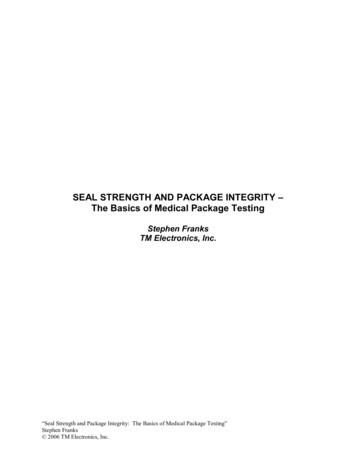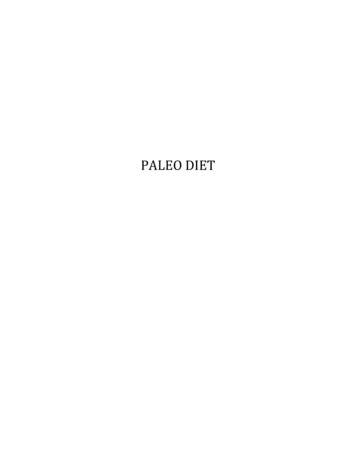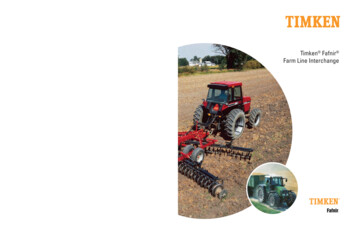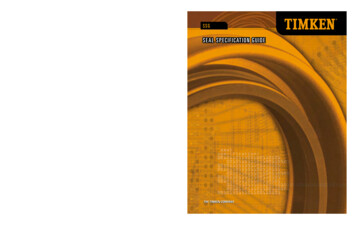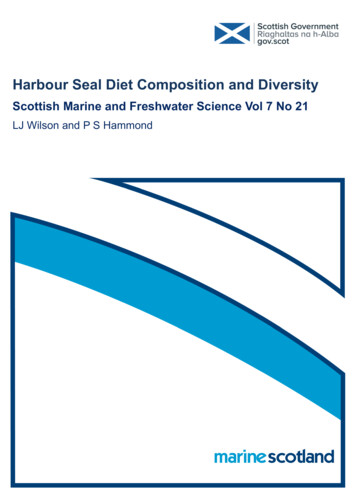
Transcription
Harbour Seal Diet Composition and DiversityScottish Marine and Freshwater Science Vol 7 No 21LJ Wilson and P S Hammond
Crown copyright 2016Harbour Seal Diet Composition and DiversityScottish Marine and Freshwater Science Report Vol 7 No 21L J Wilson and P S HammondPublished by Marine Scotland ScienceISSN: 2043-7722DOI: 10.7489/1801-1
Marine Scotland Science is the directorate of the Scottish Government responsiblefor the integrated management of Scotland’s seas. Marine Scotland Science(formerly Fisheries Research Services) provides expert scientific and technicaladvice on marine and fisheries issues. Scottish Marine and Freshwater Science is aseries of reports that publish results of research and monitoring carried out byMarine Scotland Science. It also publishes the results of marine and freshwaterscientific work that has been carried out for Marine Scotland under externalcommission. These reports are not subject to formal external peer-review.This report represents the results of marine and freshwater scientific work carried outfor Marine Scotland under external commission. Crown copyright 2016You may re-use this information (excluding logos and images) free of charge in anyformat or medium, under the terms of the Open Government Licence. To view thislicence, visit: mentlicence/version/3/ or email: psi@nationalarchives.gsi.gov.uk.Where we have identified any third party copyright information you will need to obtainpermission from the copyright holders concerned.
Harbour Seal Diet Composition and DiversityLindsay Wilson and Philip HammondSea Mammal Research UnitScottish Oceans Institute,University of St Andrews, St Andrews, Fife, KY16 8LB, UK
Contents1Executive summary. 12Introduction . 43Methods . 5453.1Fieldwork . 53.2Laboratory analysis . 123.3Estimation of diet composition . 123.4Estimation of prey consumption . 143.5Estimation of variability . 143.6Diet Diversity . 153.7Length of fish consumed . 163.8Sex-specific variation in the diet of harbour seals . 16Results. 174.1Diet composition . 174.2Diversity of prey . 184.3Size of prey consumed . 194.4Sex-specific variation in diet. 254.5Prey consumption . 34Discussion . 345.1Representativeness of scat samples. 345.2Diet composition . 375.3Size of prey consumed . 375.4The relationship between harbour seal diet and population trend . 375.4.1The importance of sandeel in the diet . 386References . 407Acknowledgements . 458Appendices . 468.1Appendix 1: Length-frequency histograms for the nine major prey species in harbour sealdiet in each region and season where prey remains were available. . 468.2Appendix 2: Estimated 95% confidence intervals of estimated diet composition, expressedas the percentage of each prey type in the diet by weight, for the main prey species. . 738.3Appendix 3: Estimated 95% confidence intervals of estimated diet composition, expressedas the percentage of each prey type in the diet by weight, for prey groups. . 778.4Appendix 4: Estimated 95% confidence intervals of estimated diet composition. . 808.5Appendix 5: Estimated 95% confidence intervals of estimated diet composition for themain prey groups. 838.6Appendix 6. Estimated 95% confidence intervals of estimated annual prey consumption(in tonnes) by harbour seals in 2010/11. . 854
1Executive SummaryPrevious studies of harbour seal diet around Scotland and elsewhere in Britain and Irelandhave described diet composition at small spatial scales. However, these studies have beenpatchy in time and space, and the most recent results are from the early 2000s. In addition,declines in harbour seal numbers have been observed since 2000 in Shetland, Orkney andeastern Scotland. Reduced availability of prey is one potential contributory cause of thesedeclines. Comparison of diet among regions that exhibit different population trajectories mayshed some light on why harbour seals are declining in some parts of Scotland but not others.The objective of this study was to provide seasonal and regional estimates of harbour sealdiet composition and regional estimates of prey consumption, and to investigate howharbour seal diet (composition and/or diversity) relates to the different population trajectoriesobserved around Scotland.Harbour seal scats were collected seasonally throughout Scotland and along the east coastof England over a 12 month period in 2010/11. Methods used to estimate diet followedthose used in previous SMRU studies of seal diet. Hard remains of prey (fish otoliths andcephalopod beaks) were recovered, identified and measured, and corrections made toaccount for partial and complete digestion. Diet composition was estimated as thepercentage, by weight, of each species in the diet for each region and season. Samplingvariability was estimated using non-parametric and parametric bootstrap resamplingmethods. Diet diversity was estimated for each region within a season using estimates ofprey species richness and the relative abundance of prey species (species evenness).Standard molecular methods were used to ascertain the sex of the seal corresponding toeach scat. A total of 1,976 harbour seal scats containing hard prey remains wereprocessed, yielding 65,534 otoliths and beaks.In the Outer Hebrides, harbour seal diet was approximately evenly split between Trisopterusspecies, pelagic fish, large gadids, scorpion fish, and sandeel. In the Inner Hebrides, largegadids were the main prey; other important species were Trisopterus species and pelagicfish. Sandeel contributed little to the diet along the west coast of Scotland. In Orkney,sandeel dominated the diet in summer and spring. Large gadids were important prey in allseasons. Pelagic prey were important in autumn. In Shetland, the diet comprised primarilypelagic prey, large gadids and sandeel.In south east Scotland the diet comprised primarily flatfish (mainly plaice) and also sandeeland large gadids. In the Moray Firth, sandeel strongly dominated the diet in all seasons. Inthe southern North Sea, there was considerable seasonal variation in diet composition. Thediet was dominated in summer by sandy benthic species, flatfish and sandeel; in autumn byflatfish, large gadids and dragonet; in winter by whiting, scorpion fish and sandy benthicprey; and in spring by flatfish and sandy benthic prey.1
The large majority of fish consumed by harbour seals were 30 cm in estimated length andthe mean size of each species was mostly below the minimum landing size for cod,haddock, whiting and plaice. The effect of harbour seal predation on fish stocks can only beassessed robustly by incorporating seal predation in fish stock assessments. However,mortality rates of the main fish species in the diet of harbour seals are mostly high sopredation on the much larger younger age classes of fish is likely to have less of an effectthan would predation on much smaller older age classes. If so, this suggests that theinteraction between harbour seals and commercial fisheries around Scotland may not beimportant for most fish species.In all regions, except the Moray Firth, there were some differences in male and female dietacross all seasons. In The Wash and Scottish west coast regions, females ate fewer largegadids than males and made up the difference in percentage contribution with sandy benthicand pelagic fish in The Wash, pelagic fish in the west coast - central region and Trisopterusspecies in the west coast - south region. The diet of male and female harbour sealsmatched most closely during the summer. This similarity in prey composition of the diet mayreflect male seals mirroring the distribution of female seals at this time of year. Overall,across all seasons, species richness and evenness did not vary greatly between the diet ofmale and female harbour seals; however, a small degree of seasonal variation wasobserved across the diet of both sexes in The Wash in winter and spring.Overall, harbour seals were estimated to have consumed 23,710 t (95% confidence interval:21,900-26,170 t) of prey in the North Sea (ICES Subarea IV) and 29,950 t (95% confidenceinterval: 26,820-32,980 t) of prey west of Scotland (ICES Division VIa) in the 12 months fromApril 2010 to March 2011, and a grand total of 53,660 t (95% confidence interval: 50,18057,400 t).Overall, no clear consistent pattern emerged to link estimated diet composition of harbourseals with observed population trends. Instead, variation in diet appeared to correspondlargely to regional and seasonal differences in prey distribution and abundance. However,there was a pattern between diet diversity and population trend. Prey species richness andevenness were generally lower in Orkney and Shetland, where harbour seals have declined,and higher in the west coast of Scotland and The Wash, southern North Sea, where harbourseals have not declined. This relationship did not hold in the Moray Firth, where the diet wasdominated by a single prey type (sandeel).Sandeel was an important component in harbour seal diet in Shetland, Orkney and theMoray Firth and quite important in southeast Scotland - all regions where populations haveshown declines. Sandeel was not an important component of the diet west of Scotland,where populations have remained stable, nor in the southern North Sea, where thepopulation is increasing.Direct comparison of results with other studies was affected by methodological differencesbut it was possible to take this into account qualitatively and draw some inferences about2
changes in harbour seal diet over time. Combining this with information on estimatedsandeel biomass from stock assessments revealed a general pattern regarding therelationship between diet and trends in population size of harbour seals. Where harbourseals have declined (northern and eastern Scotland) sandeel stocks have also declined and,although their contribution to the diet has declined, they remain an important component ofthe diet. In regions where harbour seals have not declined (west coast of Scotland, southernNorth Sea), sandeel were and remain unimportant in the diet and, in the southern North Sea,sandeel stocks have increased.Overall, with the caution that information is incomplete, the diet of harbour seals is lessdiverse and at least partially reliant on declining sandeel stocks in regions where populationdeclines have been observed, and is more diverse and not reliant on sandeels in regionswhere population declines have not been observed. A tentative conclusion is that declinesin harbour seal abundance in northern regions may be linked to a decline in the abundanceof sandeels.3
2IntroductionHarbour seal diet has been studied around Scotland and elsewhere in Britain and Irelandsince the 1980s (Pierce et al. 1991, Thompson et al. 1996, Tollit and Thompson 1996, Tollitet al. 1997, Brown and Pierce 1997, 1998, Hall et al. 1998, Brown et al. 2001, Wilson et al.2002, Pierce and Santos 2003, Sharples et al. 2009). These studies have described dietcomposition at small spatial scales in the Moray Firth, Orkney, Shetland, western Scotland,south east Scotland, Northern Ireland and The Wash, England. Together they show thatharbour seals around the British Isles feed on a variety of prey including sandeel, gadids,flatfish, herring, sprat, octopus and squid, and that diet varies seasonally and regionally.Although these earlier studies provide valuable information, the description of harbour sealdiet is patchy in time and space, and the most recent results are from the early 2000s. Inaddition, methods of analysis have improved and the results of earlier studies are subject tobias that can be accounted for in recent studies. Although the harbour seal is less numerousthan the grey seal around Britain (Duck et al. 2014, Duck and Morris 2014, Thomas 2014), itis still a major marine predator in Scottish waters and may have some impact on fishpopulations or itself be impacted by changes in prey availability. The lack of acomprehensive, up to date description of harbour seal diet hinders understanding of its rolein the marine ecosystem.Declines in harbour seal abundance have been observed in Shetland, Orkney easternScotland (Lonergan et al. 2007, Duck et al. 2014, SCOS 2015) but the cause(s) of thesedeclines are unknown (Sea Mammal Research Unit 2012, 2014). Reduced availability of asufficient quantity or quality of prey is one potential contributory cause of these declines,especially if this had an impact at a critical life history stage. Comparison of diet amongregions that exhibit different population trajectories may shed some light on why harbourseals are declining in some parts of Scotland but not others.In this report the work to address the following objectives is described: Estimate harbour seal diet composition in 2010/11, regionally and seasonally;Estimate the size of prey consumed by harbour seals, regionally and seasonally;Examine if there is sex-specific variation in harbour seal diet; Investigate how harbour seal diet relates to the different population trajectoriesobserved around Scotland; Estimate harbour seal prey consumption in 2010/11, regionally.4
3Methods3.1FieldworkScats were collected in 2010/2011 up to two hours before and after low water (derived fromPOLTIPS, National Oceanographic Centre, NERC). Scats were placed into separate plasticbags and stored at -20 C. All scats collected were expected to be no more than two weeksold (since the last spring tide).Scat collections were stratified spatially and temporally and as weather allowed. Collectionswere distributed spatially in Scotland to match the Scottish Government designated SealManagement Regions (Baxter et al. 2011) and also included The Wash in south eastEngland. All ten Special Areas of Conservation for harbour seals were included in thesampling programme. Table 1 lists all haul-out sites from which scats were successfullycollected. Samples were collected in: summer (June–August, harbour seal pupping,breeding and early moult), autumn (September–November, harbour seal end of moult andstart of the main period of foraging), winter (December–February, period mainly defined byforaging) and spring (March–May, pre-pupping), following Sharples et al. (2009). Table 2shows the numbers of scats containing fish otoliths and or cephalopod beaks collected ineach region/season and Table 3 shows the number of otoliths/beaks of each prey speciesrecovered in scats, by region.Before approaching a haul-out site, the number of harbour seals was counted and any greyseals were identified and counted. Haul-out sites were designated as a single species site ifthe area contained 80% of one species (based on a low misclassification rate of 3% inmolecular analyses to identify the species, Matejusová et al. 2013, Wilson 2014) or if theseals were spatially segregated at the haul-out site.5
Table 1Haul-out sites where harbour seal scats were successfully collected. WC west coast ndEnglandEnglandEnglandEnglandSE ScotlandSE ScotlandSE ScotlandSE ScotlandMoray FirthMoray FirthMoray FirthMoray FirthMoray FirthMoray FirthOrkneyOrkneyOrkneyOrkneyLocationThe Wash and north Norfolk coast SACThe Wash and north Norfolk coast SACThe Wash and north Norfolk coast SACThe Wash and north Norfolk coast SACThe Wash and north Norfolk coast SACThe Wash and north Norfolk coast SACThe Wash and north Norfolk coast SACThe Wash and north Norfolk coast SACThe Wash and north Norfolk coast SACFirth of Tay and Eden Estuary SACFirth of Tay and Eden Estuary SACFirth of Tay and Eden Estuary SACFirth of ForthMoray FirthMoray FirthDornoch Firth and Morrich More SACDornoch Firth and Morrich More SACBeauly FirthCromarty FirthScapa FlowEynhallow soundEynhallow soundFinstown ndShetlandOuter HebridesOuter HebridesOuter HebridesOuter HebridesWestraySanday SACShapinsayScapa FlowWestrayLunning soundMousa SACSE ShetlandSouth NestingWest mainlandWest mainlandYell Sound Coast SACYell SoundStornowaySouth UistBenbeculaHarris east6Haul-out siteFleethavenKenzie CreekEvans CreekDaseley’s SandHull SandPandora SandSeal SandThief SandStyleman’s MiddleAbertay sandsNaughtons BankRiver EdenSeafield Tower, KirkcaldyArdesierFindhornWhitenessGizzen BriggsTorrgorn BankBridgeBarrel of ButterBurgar FarmEynhallowDamsayPapa Westray, Holm ofPapayPapa Westray, Weelie'sTaingHolms of IreShapinsay, BrochSwithaSkerry of WastbistLunning Sound IslandsMousaVoe of SoundSkudill’s WickBixter voeVementryLunna Ness, Sand SkerryLunna Ness, Little HolmBroad Bay, Sgeir LeathannLoch AineortFlodaighEast Loch Tarbert
Outer HebridesWC - northWC - northWC - northWC - northWC - centralWC - centralWC - centralWC - centralWC - centralWC - centralWC - centralWC - southWC - southWC - southWC - southWC - southWC - southWC - southWC - southLoch MaddySummer IslesSummer IslesOldany IslandsLoch Glen Coul IslandsInner SoundAscrib, Isay and Dunvegan SACAscrib, Isay and Dunvegan SACAscrib, Isay and Dunvegan SACLoch DunveganLoch DunveganPlock of KyleArdfernGighaGighaSouth-East Islay Skerries SACSouth-East Islay Skerries SACJuraJuraEileanan agus Sgeiran Lios mór SAC7Loch MaddySgeirean GlasaCarn naan SgierOldanay IslandsLoch Glen Coul IslandsCrowlin IslandsAscrib IslandsDunvegan Castle IslandsDunvegan west IslandsLoch Bay, MingayLoch Bay, Sgeir nam BiastSkye Bridge skerriesEiean na CillieCara ReefCaolas GigalumPlod SgeireanLoch a'ChnuicLowlandsman BayWest Loch TarbertEilean Dubh skerry
Table 2Number of harbour seal scat samples (containing hard parts that were processed) collectedby season in 2010/11 and the total number of hard parts (fish otoliths and cephalopodbeaks) recovered. WC west coast of Scotland.RegionThe WashThe WashThe WashThe WashSE ScotlandSE ScotlandSE ScotlandSE ScotlandMoray FirthMoray FirthMoray FirthMoray andShetlandOuter HebridesOuter HebridesOuter HebridesOuter HebridesWC - northWC - northWC - northWC - northWC - centralWC - centralWC - centralWC - centralWC - southWC - southWC - southWC - ingSummerAutumnWinterSpringNumberof aks 01,5631,7901,5206032,7831,565368905
Table 3: Number of fish otoliths and cephalopod beaks recovered from harbour seal scats in 2010/11. WC west coast of 001WC north5021641627855380722023000000WC central868219767586011812311161506212000WC 5041,2201,1181,072962123908017149432211TOTALNorway poutPoor codUnid. TrisopterusNorway pout or Poor codPout 25810,932SandeelTOTAL rey groupPrey speciesWhitingUnid. gadidBlue whitingCodSaitheHaddockSilvery poutRocklingLingHake3-bearded rocklingSaithe or Pollock4-bearded rocklingForkbeardPollockTadpole fish5-bearded rocklingSea snailGadid9
Prey groupPrey speciesPlaiceUnid. flatfishDabFlounderDover soleLemon soleWitchLong rough dabFlounder or PlaiceThickback soleBrillNorwegian topknotUnid. 000000000WC north8100011000050000WC central311620011392408044010WC TOTALSea ScorpionBullroutUnid. CottidaeHooknoseGurnardGrey 0571276511250511614812205SandybenthicScorpion fishTOTAL10
Prey groupPrey speciesHerringSpratMackerelHorse 034100OuterHebrides190232200WC north750311870WC central18001986180WC id. SalmonidSea is 0237230108260502CephalopodTOTALWrasseUnknown SpeciesUnid. roundfishSnake blennyLesser weeverGarfishEelpoutCuckoo wrasseConger eelBassBallan ,3833,7137,7116,81465,534TOTAL11
3.2Laboratory AnalysisIndividual scats were defrosted, placed in nested mesh bags (inner 350 µm, outer 240 µm)and soaked in warm water with 25 g detergent (Dreft) for 2-24 h. Scats were subsequentlymachine washed (Orr et al. 2004), following the protocol developed by S. Brasseur (pers.comm.); that is, on a 2 h 40 C pre-wash with 50 g detergent and 0.5 h wool wash at 40 Cwith 50 g detergent, the spin cycle was deactivated for all wash cycles. If pebbles had beenpicked up as part of an individual scat collection, otoliths and beaks were extracted usingrunning water through a nest of sieves to avoid damage to prey hard remains; mesh sizes 1mm, 600 µm, 335 µm and 250 µm. The presence of other possible prey remains (e.g.feathers and crustacean carapaces) was noted.Otoliths were stored dry and identified by John Watkins to the lowest possible taxonomicgroup based on morphological criteria using a reference collection and identification guides(Härkönen 1986, Leopold et al. 2001). Beaks were stored in 70% IMS and identified tospecies by Caya Sievers using a reference collection and identification guide (Clarke 1986).Where prey remains could not be identified to species, they were recorded at a higher level(e.g. sandeel, unidentified gadid).Otolith lengths and widths and cephalopod lower rostral or lower hood lengths weremeasured to the nearest 0.01 mm using digital callipers (Mitutoyo) under binocularmicroscopes. Broken otoliths and beaks were counted and measured only if thewidest/longest part of the otolith, or the lower beak, was unbroken. Fragments of otoliths orbeaks which were not large enough to be measured were not counted or measured to avoidmisidentification of species and double counting.All counted otoliths and beaks were measured unless a large number of a prey speciesoccurred in a scat. In such cases, 30 otoliths were randomly chosen with respect to size andmeasured if there were 30-120 otoliths or beaks of the same species in a scat, and 25%were randomly chosen and measured if there were greater than 120 otoliths or beaks of thesame species.The degree by which each measured otolith was digested was recorded after examination ofindividual morphological features (Tollit et al. 1997, Leopold et al. 2001). Four grades ofdigestion were allocated; grade 1 - pristine, grade 2 - moderately digested, grade 3 considerably digested, and grade 4 - severely digested (Wilson et al. 2013, Wilson 2014).The amount by which cephalopod beaks had been digested was not classified.3.3Estimation of Diet CompositionAll data processing and analysis was conducted using a suite of analysis programs written insoftware R (R Core Development Team 2013).12
Estimation of harbour seal diet composition generally followed the methods used in previousassessments of grey seal diet by SMRU. Measurements of the size of otoliths/beaksrecovered from scats were corrected for partial digestion and used to estimate the weight ofprey ingested, values were summed over species, corrected for complete digestion, andexpressed as percentages of the diet by weight (Prime and Hammond 1987, 1990,Hammond et al. 1994a, 1994b, Hammond and Rothery 1996, Hall et al. 1998, Hammondand Grellier 2006, Hammond and Harris 2006, Sharples et al. 2009).Measurements of partially digested otolith/beak size were converted to estimates ofundigested otolith/beak size using experimentally derived grade-specific digestioncoefficients (Tollit et al. 1997, Wilson et al. 2013, Wilson 2014). For each prey species (orhigher taxon) the preferred measurement (otolith length or width, or lower rostral or lowerhood length) was determined based on the availability of experimental data, the precision ofthe estimated digestion coefficients (Tollit et al. 1997, Wilson et al. 2013, Wilson 2014), themeasurement available from recovered hard parts and the availability of regressionequations to estimate prey size. Where species specific correction factors were notavailable, group-specific values were used (e.g. gadids, flatfish) or values from prey specieswith otoliths of similar size and robustness (Härkönen 1986) were applied. The use ofvalues from other species only occurred for prey species that were minor components of thediet.For some prey species there was no suitable substitution and general “round fish” digestioncoefficients were used. For dragonet (Callionymus lyra) and Cottidae species, digestioncoefficients (DCs) were only available for grey seals (Grellier and Hammond 2006).Species-on-species comparison showed that harbour seal digestion coefficients weregenerally smaller than grey seal DCs (by 8.3%, on average). Grey seal DCs for dragonetand short-spined sea scorpion (bullrout) were, therefore, multiplied by 0.917 to use forharbour seals. For herring, estimated fish size was sensitive to the choice of DC. Based ona comparison of available DCs, the species-specific DC generated by Tollit et al. (1997)provided the most realistic estimates of fish size and was, therefore, used in analysis.Estimates of fish/cephalopod weight were derived from the estimates of undigestedotolith/beak size using allometric equations (Clarke 1986, Härkönen 1986, Leopold et al.2001, Santos et al. 2001, GJ Pierce and MB Santos pers. comm.). Where no equationswere available for prey species, equations for the closest matching species were used; thesespecies were all minor prey.For scats in which a sub-sample of the otoliths identified for a species had been measured,the fish weight represented by each unmeasured otolith was assumed
Diet diversity was estimated for each region within a season using estimates of prey species richness and the relative abundance of prey species (species evenness). Standard molecular methods were used to ascertain the sex of the seal corresponding to each scat. A total of 1,976 harbour seal scats containing hard prey remains were



